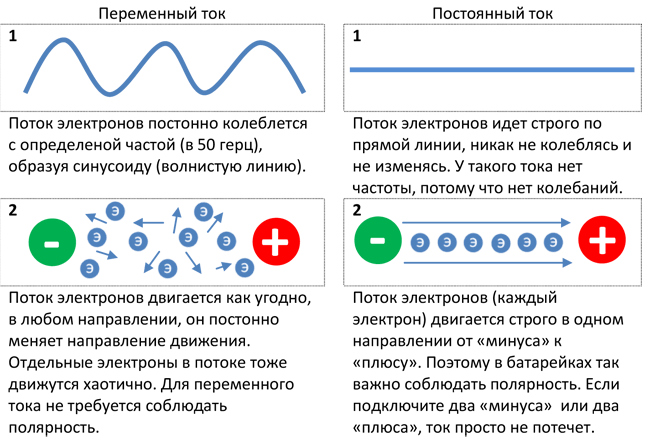What is more dangerous for a person - alternating or direct current?
The difference between the two compared options
So, first of all, we will briefly explain to you what the difference between alternating current and direct current. The main difference is that in the first case, the directional movement of charged particles will take place directly, and in the second in a chaotic direction. The graph below clearly shows the difference between the two compared options and at the same time provides a brief description of how the alternating and constant electric current flows in the circuit.
In addition, it should be added that direct current at home most often flows in lamps - for example, if the room is provided hidden LED strip light. At the same time, the variable flows in all outlets, junction boxes and the shield, so its danger to human life is more relevant.
Values dangerous to humans
As we said earlier, the danger of electric current for human life depends on what value of voltage and frequency of oscillation will flow in the circuit. In order to correctly answer the question of which current is more dangerous, we consider all possible values and their ranges.
- Oscillation frequency. In a household electrical network is 50 Hz. At a frequency of 10 to 500 Hz, alternating current is equally dangerous to humans. In the range from 500 to 1000 Hz, the danger increases markedly. Alternating electric current with an oscillation frequency above 1000 Hz is less dangerous for life. It should also be noted that a constant electric current is about 3-4 times safer than an alternating current if the oscillation frequency of the latter is 50 Hz.
- Voltage. If the voltage in the network does not exceed 400 volts, then in this case an alternating electric current is more dangerous than a direct current. In the range of 400-600 volts, the compared options are approximately equally dangerous for human life. If the voltage in the network is an order of magnitude higher than 500 volts, the danger of a constant electric current increases and in this case the variable is considered not so dangerous.
Also, you should separately draw your attention to such a value as the current strength. This parameter is considered safe if it does not exceed 10 mA with alternating current and 50 mA with constant current. If we compare the danger by Amperes, then we can say with confidence that with the same values, the variable will be more dangerous for a person than a constant.
That's all I wanted to tell you about this issue.We hope that you are aware of all the dangers of exposure to electricity, and that when you conduct electrical work, take your electrical safety as seriously as possible! One way or another, for domestic conditions, one can confidently answer the question of which electric current is more dangerous for humans. If direct current is used only in lighting, then it is not as dangerous as alternating current (in sockets, junction boxes and a panel)! We also recommend that you read the equally important article - what tools should a home electrician have!







